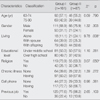Abstract
Purpose
The purpose of this study was to investigate the factors associated with social isolation in older adults using a senior welfare center.
Methods
This study was a cross-sectional survey. Data was collected from June to August 2006 using a questionnaire. A total of 248 older adults responded.
Results
About one third (34.9%) of participants responded they felt socially isolated. There were statistically significant differences in living, religion, family and belongingness social support, loneliness, depression, family function, perceived health status, and number of chronic illnesses between socially isolated and non isolated groups. However, factors influencing social isolation were family function (OR=0.954, CI=0.926-0.982), loneliness (OR=1.042, CI=1.002-1.083), depression (OR=1.041, CI=1.002-1.081), and number of chronic illness (OR=1.657, CI=1.153-2.382).
Conclusion
We found that some older adults were feeling socially isolated even though the senior welfare center was a good place to meet people. The findings of this study indicated that older adults suffering from social isolation need special attention and may benefit from interventions which promote health and social interactions. Further studies are needed to develop and evaluate an intervention program for this population.
Figures and Tables
References
1. Adams KB, Sanders S, Auth EA. Loneliness and depression in independent living retirement communities: Risk and resilience factors. Aging & Mental Health. 2004. 8:475–485.
2. Andersson L. Loneliness research and interventions: A review of the literature. Aging & Mental Health. 1998. 2:264–274.
3. Andrews GJ, Gavin N, Begley S, Brodie D. Assisting friendships, combating loneliness: Users' views on a 'befriending' scheme. Ageing & Society. 2003. 23:349–362.
4. Antonucci TC, Akiyama H. Social networks in adult life and a preliminary examination of the convoy model. Journal of Gerontology. 1987. 42:519–527.
5. Blazer DG. Self-efficacy and depression in late life: A primary prevention proposal. Aging & Mental Health. 2002. 6:315–324.
6. Bondevik M, Skogstad A. The oldest old, ADL, social network, and loneliness. Western Journal of Nursing Research. 1998. 20:325–343.
7. Clarke M, Clarke SJ, Jagger C. Social intervention and the elderly: A randomized controlled trial. American Journal of Epidemiology. 1992. 136:1517–1523.
8. Fees BS, Martin P, Poon LW. A model of loneliness in older adults. The Journals of Gerontology Series B, Psychological Sciences and Social Sciences. 1999. 54:231–239.
9. Han IY, Chung SD. Linkage effects of new social support system for the elderly women living alone. Journal of the Korea Gerontological Society. 2002. 21:145–156.
10. Havens B, Hall M. Social isolation, loneliness, and the health of older adults in Manitoba, Canada. Indian Journal of Gerontology. 2001. 15:126–144.
11. Havens B, Hall M, Sylvestre G, Jivan T. Social isolation and loneliness: Differences between older rural and urban Manitobans. Canadian Journal on Aging. 2004. 23:129–140.
12. Holmén K, Furukawa H. Loneliness, health and social network among elderly people-a follow-up study. Archives of Gerontology & Geriatrics. 2002. 35:261–274.
13. Ionedes NJ. An exploration of social interest therapy as a treatment for depression in the elderly. 2008. Minesota, USA: Capella University;Unpublished doctoral dissertation.
14. Jee Y, Goo C. The differences of abilities to physical activity, social networks, depression degrees of elderly between residing rural and urban. Journal of Coaching Development. 2007. 9:425–439.
15. Chon KK, Rhee MK. Preliminary development of Korean version of CES-D. Korean Journal of Clinical Psychology. 1992. 11:65–76.
16. Kim OS. Korean version of the revised UCLA loneliness scale: Reliability and Validity test. Journal of Korean Academy of Nursing. 1997. 27:871–879.
17. Kim OS, Baik SH. The relationships among loneliness, social support, and family function in elderly Korean. Journal of Korean Academy of Nursing. 2003. 33:425–432.
18. Kim HN, Jung MS. The study for activating elderly's utilization of leisure programs based on the needs of the elderly using community welfare institutions. Journal of Welfare for the Aged. 2004. 26:263–285.
19. Kwon JD. Social welfare of the elderly. 2004. Seoul: Hakjisha.
20. Lee IS, Park YS, Song MS, Lee EO, Kim HS, Park YH, et al. A study on the development of the Korean family functioning scale. Journal of Korean Academy of Nursing. 2002. 32:395–405.
21. Na HJ. An study of leisure of the elderly for successful aging. Journal of Welfare for the Aged. 2002. 18:131–163.
22. Owen T. Working with socially isolated older people. British Journal of Community Nursing. 2007. 12:115–116.
23. Park IS. Influence of participation in leisure program at welfare center for senior on successful aging. 2006. Seoul: Kookmin University;Unpublished doctoral dissertation.
24. Prince MJ, Harwood RH, Thomas A, Mann AH. A prospective population-based cohort study of the effects of disablementand social milieu on the onset and maintenance of late-life depression. The Gospel Oak Project VII. Psychological Medicine. 1998. 28:337–350.
25. Rokach A. Surviving and coping with loneliness. The Journal of Psychology. 1990. 124:39–54.
26. Routasalo PE, Savikko N, Tilvis RS, Strandberg TE, Pitkälä KH. Social contacts and their relationship to loneliness among aged people-a population-based study. Gerontology. 2006. 52:181–187.
27. Savikko N, Routasalo P, Tilvis RS, Strandberg TE, Pitkälä KH. Predictors and subjective causes of loneliness in an aged population. Archives of Gerontology and Geriatrics. 2005. 41:223–233.
28. Tilvis RS, Pitkala KH, Jolkkonen J, Strandberg TE. Social networks and dementia. Lancet. 2000. 356:77–78.
29. Tomaka J, Thompson S, Palacios R. The relation of social isolation, loneliness, and social support to disease outcomes among the elderly. Journal of Aging and Health. 2006. 18:359–384.
30. Victor C, Scambler S, Bond J, Bowling A. Being alone in later life: Loneliness, social isolation and living alone. Reviews in Clinical Gerontology. 2000. 10:407–417.




 PDF
PDF ePub
ePub Citation
Citation Print
Print





 XML Download
XML Download